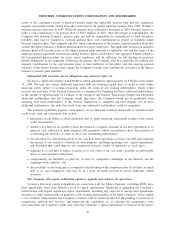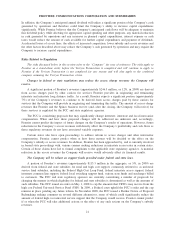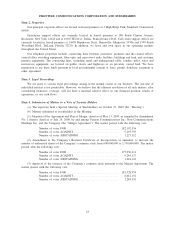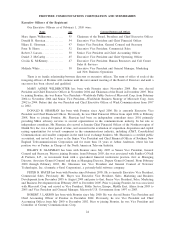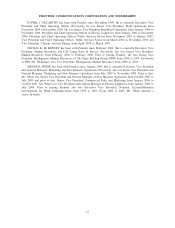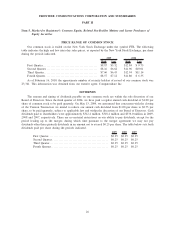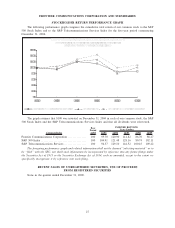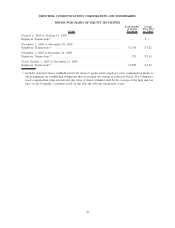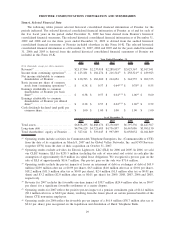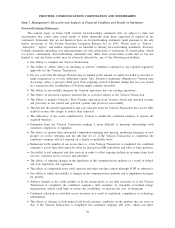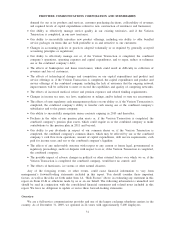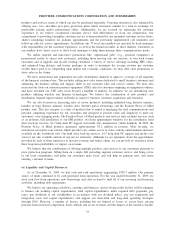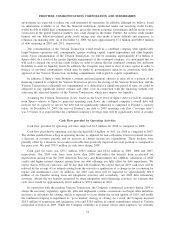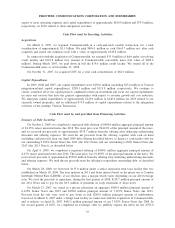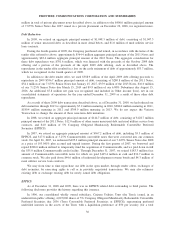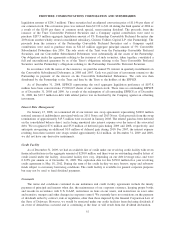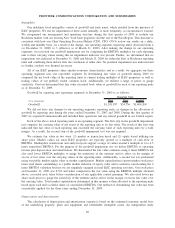Frontier Communications 2009 Annual Report Download - page 32
Download and view the complete annual report
Please find page 32 of the 2009 Frontier Communications annual report below. You can navigate through the pages in the report by either clicking on the pages listed below, or by using the keyword search tool below to find specific information within the annual report.Item 7. Management’s Discussion and Analysis of Financial Condition and Results of Operations
Forward-Looking Statements
This annual report on Form 10-K contains forward-looking statements that are subject to risks and
uncertainties that could cause actual results to differ materially from those expressed or implied in the
statements. Statements that are not historical facts are forward-looking statements made pursuant to the safe
harbor provisions of The Private Securities Litigation Reform Act of 1995. Words such as “believe,”
“anticipate,” “expect” and similar expressions are intended to identify forward-looking statements. Forward-
looking statements (including oral representations) are only predictions or statements of current plans, which
we review continuously. Forward-looking statements may differ from actual future results due to, but not
limited to, and our future results may be adversely affected by, any of the following possibilities:
•Our ability to complete the Verizon Transaction;
•The failure to obtain, delays in obtaining or adverse conditions contained in any required regulatory
approvals for the Verizon Transaction;
•For two years after the merger, Frontier may be limited in the amount of capital stock that it can issue to
make acquisitions or to raise additional capital. Also, Frontier’s indemnity obligation to Verizon may
discourage, delay or prevent a third party from acquiring control of Frontier during this two-year period
in a transaction that stockholders of Frontier might consider favorable;
•The ability to successfully integrate the Verizon operations into our existing operations;
•The effects of increased expenses incurred due to activities related to the Verizon Transaction;
•The ability to migrate Verizon’s West Virginia operations from Verizon owned and operated systems
and processes to our owned and operated systems and processes successfully;
•The risk that the growth opportunities and cost synergies from the Verizon Transaction may not be fully
realized or may take longer to realize than expected;
•The sufficiency of the assets contributed by Verizon to enable the combined company to operate the
acquired business;
•Disruption from the Verizon Transaction making it more difficult to maintain relationships with
customers, employees or suppliers;
•The effects of greater than anticipated competition requiring new pricing, marketing strategies or new
product or service offerings and the risk that we or, if the Verizon Transaction is completed, the
combined company will not respond on a timely or profitable basis;
•Reductions in the number of our access lines or, if the Verizon Transaction is completed, the combined
company’s access lines that cannot be offset by increases in HSI subscribers and sales of other products;
•Our ability to sell enhanced and data services in order to offset ongoing declines in revenues from local
services, switched access services and subsidies;
•The effects of ongoing changes in the regulation of the communications industry as a result of federal
and state legislation and regulation;
•The effects of competition from cable, wireless and other wireline carriers (through VOIP or otherwise);
•Our ability to adjust successfully to changes in the communications industry and to implement strategies
for growth;
•Adverse changes in the credit markets or in the ratings given to our debt securities or, if the Verizon
Transaction is completed, the combined company’s debt securities, by nationally accredited ratings
organizations, which could limit or restrict the availability, or increase the cost, of financing;
•Continued reductions in switched access revenues as a result of regulation, competition or technology
substitutions;
•The effects of changes in both general and local economic conditions on the markets that we serve or
that, if the Verizon Transaction is completed, the combined company will serve, which can affect
30
FRONTIER COMMUNICATIONS CORPORATION AND SUBSIDIARIES


